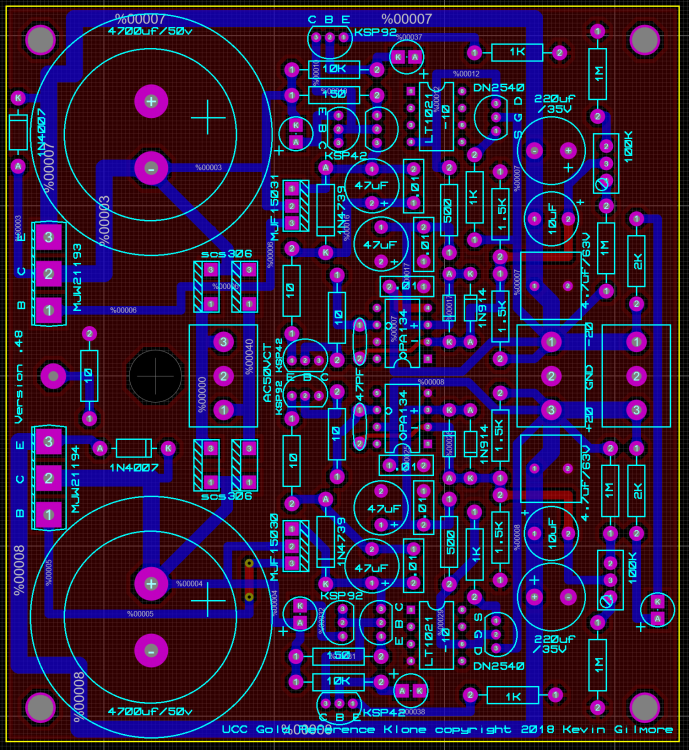-
Posts
7,109 -
Joined
-
Last visited
-
Days Won
21
Content Type
Profiles
Forums
Events
Everything posted by kevin gilmore
-
Even with the grossly inflated prices cavalli eventually went under due to too many hands in the cookie jar and shit quality requiring a lot of repairs, especially the liquid carbon. when there was only one standard for measuring distortion it was easy. Now that there are a number of adc based distortion devices each with different firmware and software, and digital filters you can generate impossibly low distortion numbers that are meaningless. jude might want to look at how measurements were done many moons ago and emulate that. Far more useful information. i think a reasonable number on sales exceed 8M$ over the 8 year life of cavalli. Lots of people are going to take a bath, just like singlepower
-
the thd+N is .0075%, and although it does not specify, its likely at 1khz. look at the schematic posted above. about 15db of feedback around the grid of the tube. Lowering the input impedance to bipolar levels or lower and kind of negating any possible use of an input tube. Also the plate current source. spice indicates a second harmonic distortion of -74db at 1khz (.02%) and a 3rd harmonic distortion of -109db (.0003%) at 1khz however at 10khz the second harmonic is -60db (.1%) and the third harmonic is -96db (.002%) you can work out the summation on your own. plus of course the messed up soundstage due to the inverse phase. Something the plankton experts seem to ignore. In reality, with an old school analog thd meter, the numbers are going to be much much higher. and of course this is all measured with a 300 ohm resistor. Use a real load especially low impedance, and the numbers go way up.
-
2nd harmonic and 3rd harmonic vs frequency is what influences sound signature the most. bipolar vs mosfet outputs makes the most difference. there is no cavalli house sound. This amp is bipolar outputs, the LCX is mosfet.
-
because i'm lazy, taobao links for liquid gold clone and LL please. approximate schematic here. too lazy to finish the plate servo. some resistor values obviously wrong, probing from here with voltmeter to Iceland seems unreliable. (and kinda slow) .1% thd at 10khz 2nd harmonic. which is not that horrible cth2.PDF
-
Going thru the schematic its kind of obvious that for the 1/4 jack, this amplifier inverts phase. Not sure about whether the wiring on the 4 pin is flipped to fix this problem. people sensitive to phase, or at least notice the difference, and this amp is going to sound different.
-
8significant areas on both units have circuit board heatsink area. Still you could easily attach real heatsinks to those areas and put more holes in the case to let the heat out. And then bias up the output a bit more. This one uses a 28V power supply. So output rails are +/-14v, pretty low voltage swing. Outputs are MJD243/MJD253 and are bipolar. tube is current source plate load, capacitor coupled to a virtually identical copy of the liquid carbon output stage (current feedback/bipolar) with a different servo.
-
If the new LCX sounds worse than the original, its probably because of the rail splitter, otherwise the circuitry and parts are identical. I have never seen a rail splitter test well. The original squarewaves all burned up due to heat and other stupidity, but otherwise sounded really nice, still the only headphone amp I know of that is both current feedback and all of the voltage gain in the output stage. The re-done version is still a sweet but low powered amp. dynalo and supersymmetry dynalo still out perform everything else in their power class and as far as I know, no one has ever been able to burn one up.
-
massdrop and schiit seem to be trying to out cheap each other. clearly this thing is much better built than the original for less than half the price. whether the protection circuit will prevent it from blowing up if you insert unbalanced and balanced headphones is currently unknown. but cost cutting is evident everywhere. external switcher removes the need for line power inside the chassis (joutenheim) and the AC rated power switch. But rail splitter causes all sorts of issues. Virtually no heatsinking so the amp runs pretty much class B. etc the CTH is the same thing. More rail splitter because its single ended.
-
I wonder if amb knows that alex is using his protection circuit?
-
well at least it has a dc protection circuit which the original did not have, and its sure going to need it, absolutely no heatsinking of any kind. OH look, a rail splitter that's necessary because of the ultra cheap single output switching brick. At least its actually built better than the original at less than half the cost. i'll bet that plugging in both unbalanced and balanced headphones is going to cause it to blow up. just like the original
-
it is one board per channel for the tube. your choice of tube front or tube back (different layouts)
-
don't build the DHT one unless you plan on spending piles of cash on tubes
-
I really like that knob
-
845 in a megatron configuration is what you want
-
so the options for the new woo amp 1) plate resistors, they already said its not this 2) inductors, they already said its not this 3) center tapped inductor, you get about 6db of gain with this. 3a) push pull output transformer. all sorts of issues with gain and power with this 4) solid state current source maximum voltage gain of 6sn7 is about 20, maximum voltage gain of 300b is less than 4 somewhere there are likely to be input/interstage transformers and then you are still going to have trouble getting to a voltage gain of 500 or more if you want some feedback to reduce the distortion. the viva evidently is also low on gain, and uses and output transformer. why people produce shit like this I do not know
-

KG Balanced Dynahi build discussion thread
kevin gilmore replied to Vortex's topic in Do It Yourself
pretty sure it was posted that340.zip -
That is a 30 amp nema connector.
-
Stax mafia boards linked to in the stax mafia boards thread i highly recommend you doing a diy-t2 as your first amplifier. More than one person has done this. If you survive you will learn a lot less dangerous is the supersymmetry dynalo with the golden reference power supply then the current feedback amp balanced or single ended with the golden reference power supply more challenging is the uber2 amp
-
i'm not sure that the burson like things are going to be good for servo opamps. from what I have seen all of these things are bipolar input and have significant input offset current. Plus they drift with temperature. A low offset jfet input slow opamp is what you want for a servo
-
on the ksa5 the servo's are in the negative feedback loop. So they can influence the sound a little bit.
-
the circlotron boards are 900V
-

goldenreference low voltage power supply
kevin gilmore replied to kevin gilmore's topic in Do It Yourself
same size board, up to 35mm caps, had to move the pass transistors, needs checking silicon carbide rectifiers 100mm x 109mm goldenreferencelargecap.zip -
that was for the alps quad pots as I remember
-

goldenreference low voltage power supply
kevin gilmore replied to kevin gilmore's topic in Do It Yourself
The Zener voltage minus 1.4V (darlington) plus about 1 V across the control transistor specifies the minimum output voltage. The zener guarantees enough start up voltage to power up the opamp so something like 8v with a 5v reference -

goldenreference low voltage power supply
kevin gilmore replied to kevin gilmore's topic in Do It Yourself
The opamp needs to be able to run on what the output voltage is, and the zener plus 1.4V has to be less than the desired output voltage.






